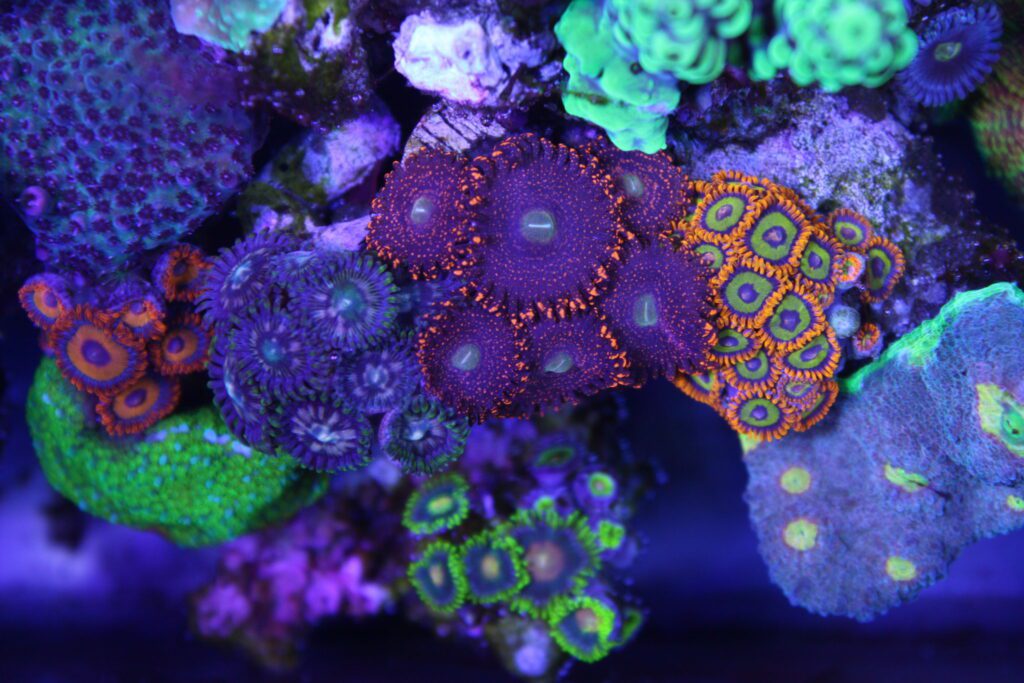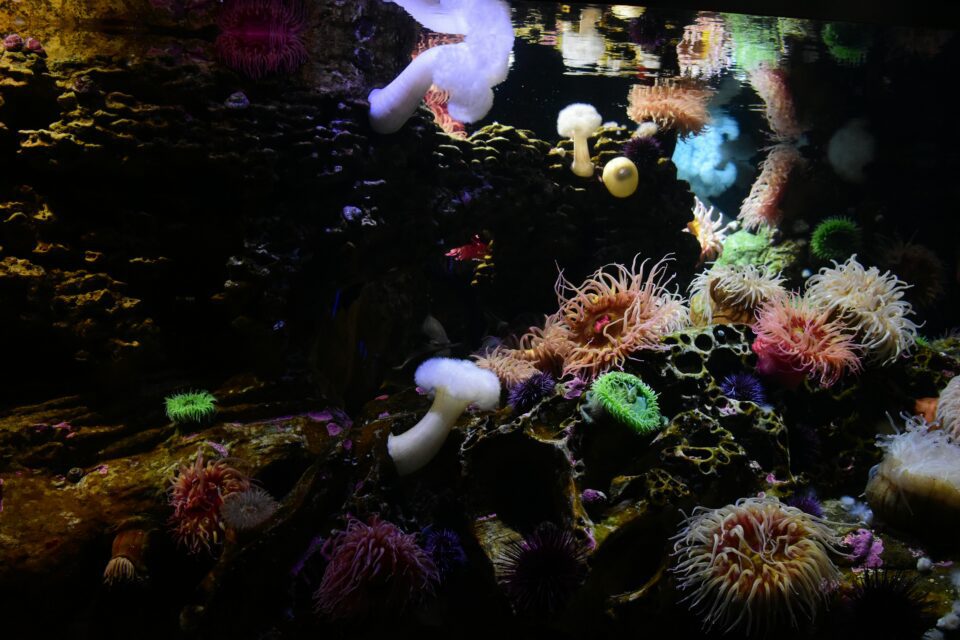Introduction: Zoanthid corals, commonly known as “zoas,” are a favorite among saltwater aquarium enthusiasts for their striking colors and relatively easy care. These corals are not only vibrant and beautiful but also serve as an excellent entry point for newcomers to the reef-keeping hobby. This post delves deep into the most frequently asked questions about Zoanthid corals, offering comprehensive care tips, troubleshooting advice, and insights into their propagation.

What Are Zoanthid Corals? Zoanthids belong to the Zoantharia order and are characterized by their soft, colorful polyps connected by a mat-like coenenchyme. Each polyp features a central mouth surrounded by tentacles used for feeding. Known for their stunning array of hues—from deep blues to radiant reds—zoanthids can dramatically enhance the visual appeal of any aquarium.
How Do You Care for Zoanthid Corals?
- Lighting: Optimal lighting for zoanthids typically involves moderate to high intensity. LEDs are preferred for their adjustability, allowing you to customize the light spectrum and intensity to match the needs of your specific zoas. Too little light may cause zoas to fade, while too much can lead to bleaching.
- Water Flow: Zoanthids do well with moderate and indirect water flow. This helps keep the polyps free from detritus and excess algae while providing them with the necessary nutrients and gases. Direct, strong flow can prevent polyps from fully opening and may cause stress.
- Water Quality: Stability is key in maintaining healthy zoanthids. They thrive in water temperatures of 76-78°F and salinity levels of 1.023-1.025. Regular water testing and maintenance are essential to control nitrates and phosphates, which should be kept as low as possible to avoid promoting algae growth that can compete with or smother zoanthids.
Are Zoanthids Easy to Propagate? Zoanthids are exceptionally propagation-friendly. Hobbyists can propagate zoas by carefully separating polyps using a sharp blade, ensuring each fragment includes part of the base mat. These frags should then be placed on frag plugs or directly on rockwork where they can attach and gradually form new colonies. Proper handling and adequate healing time in optimal water conditions ensure successful propagation.
Can Zoanthids Be Toxic? One significant caution with zoanthids is their potential toxicity. They produce palytoxin, one of the most dangerous toxins found in marine organisms, which can be harmful if ingested or if it comes into contact with cuts on the skin. It’s vital to wear gloves when handling zoas and to wash hands thoroughly afterwards.
Why Are My Zoanthids Not Opening? Zoanthids might remain closed due to several issues:
- Water Quality: Elevated nitrate or phosphate levels can stress zoanthids.
- Lighting and Flow Adjustments: Inadequate lighting or improper flow may need adjustments.
- Pest Infestations: Common pests include zoa pox and nudibranchs, which can be treated with dips and careful tank maintenance.

How Long Do Zoanthids Take to Grow? Growth rates for zoanthids vary widely depending on their environment and care. With optimal conditions, new polyps can appear within a few weeks. Factors influencing growth include the species, lighting, flow, and overall stability of the tank.
What Are the Best Tank Mates for Zoanthids? Zoanthids generally coexist well with other coral species, especially other soft corals and some types of LPS (Large Polyp Stony) corals. It’s crucial to avoid coral species that are overly aggressive or those that might overshadow or physically damage the zoas. Suitable tank mates include mushrooms, bubble corals, and some species of montipora.
How Should Zoanthids Be Acclimated to a New Tank? Acclimate zoanthids slowly to ensure they adjust to the specific parameters of your tank. Start by floating the bag in the tank to equalize temperature. Then, gradually introduce tank water to the bag over a period of an hour to help the zoas adjust to pH, salinity, and other chemical conditions.
What Are the Signs of Healthy Zoanthids? Healthy zoanthids typically display vibrant colors and are open during the day when the lights are on. They should attach firmly to the substrate or rockwork, and new polyp growth should be evident with proper care.
How Do Zoanthids Feed? Zoanthids can photosynthesize via symbiotic algae known as zooxanthellae living in their tissues, but they also benefit from supplemental feeding. Targeted feeding with fine particulate foods, like zooplankton or finely minced seafood, can promote growth and vibrancy.
Can Zoanthids Recover from Bleaching? Zoanthids can sometimes recover from bleaching if the underlying issues (usually lighting intensity or water quality) are promptly corrected. Supporting recovery with stable, pristine water conditions and careful feeding can help bleached zoas regain their color over time.
Conclusion: Zoanthid corals are not just a visual delight for any saltwater aquarium but also a testament to the resilience and diversity of marine life. By understanding their care requirements and recognizing signs of distress, hobbyists can enjoy the dynamic beauty of these corals for years to come. Whether you’re a novice or a seasoned aquarist, zoanthids offer a rewarding and engaging experience in the reef-keeping hobby.




